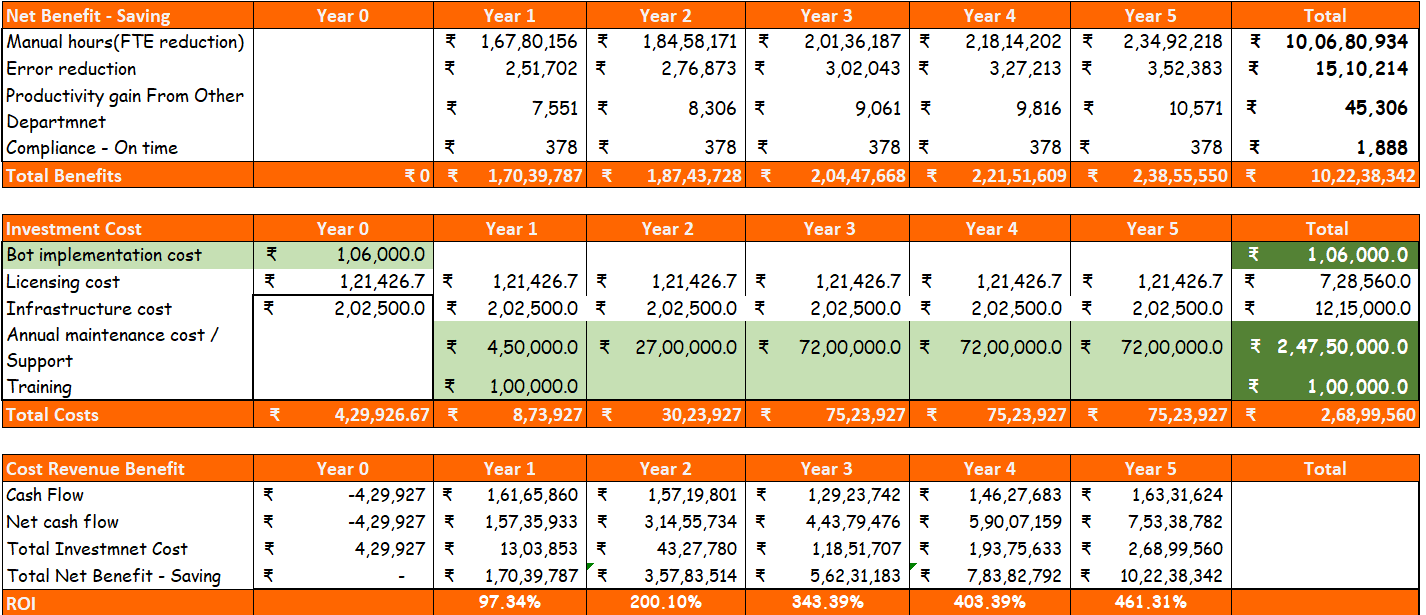
Why Calculate ROI in RPA?
- Informed Decision-Making: Helps in assessing the feasibility and financial viability of RPA implementation.
- Stakeholder Buy-In: Demonstrates clear benefits to management and other stakeholders.
- Optimization of Resources: Identifies high-value processes that maximize returns.
Key Components for ROI Calculation
To accurately measure ROI, you must consider the following:

1. Costs of RPA Implementation
- Software Costs: Licensing fees for RPA tools like UiPath, Automation Anywhere, or Blue Prism.
- Infrastructure Costs: Cloud or on-premises deployment expenses.
- Development Costs: Costs for designing, building, and testing bots.
- Maintenance Costs: Ongoing support, updates, and monitoring expenses.
- Training Costs: Upskilling staff to manage and work alongside RPA.
2. Benefits of RPA
- Cost Savings: Reduction in manual effort and FTE (Full-Time Equivalent) hours.
- Productivity Gains: Bots can work 24/7 without fatigue.
- Error Reduction: Fewer mistakes lead to savings on rework and compliance penalties.
- Scalability: Automation allows businesses to scale operations without proportionate cost increases.
3. Timeframe for ROI
Define the period over which ROI will be measured (e.g., 1 year, 5 years).
ROI Formula for RPA
The standard ROI formula can be applied to RPA as follows:
ROI (%) = (Total Benefits−Total Costs / Total Costs) *100
Steps to Calculate ROI in RPA
Step 1: Identify the Process for Automation
- Assess processes based on volume, complexity, error rates, and potential impact.
- Use a scoring matrix to prioritize high-value processes.
Step 2: Quantify Pre-Automation Metrics
- Calculate the current cost of manual execution (e.g., FTE costs, error correction costs).
- Measure process cycle times and volumes.
Step 3: Estimate RPA Implementation Costs
- Gather quotes for RPA licenses, development resources, and infrastructure.
- Include hidden costs like training and change management.
Step 4: Forecast Post-Automation Metrics
- Estimate the reduction in manual hours and corresponding cost savings.
- Factor in additional benefits like improved accuracy, compliance, and customer satisfaction.
Step 5: Calculate Total Benefits
Total Benefits =
- Annual savings in labor costs
- Savings from error reduction
- Productivity gains
Step 6: Perform the ROI Calculation
Use the formula to compute ROI and assess the payback period (time required to recover the initial investment).
Example ROI Calculation
Scenario: Invoice Processing Automation
- Current Process Cost: 10 FTEs, $50,000 annual salary per FTE.
- Post-Automation Cost: 2 FTEs for exception handling.
- Automation Costs:
- RPA Software: $30,000/year (UiPath Tool)
- Development: $50,000 (one-time)
- Maintenance: $10,000/year
Calculation:
- Pre-Automation Costs: 10×50,000=500,00010 \times 50,000 = 500,000
- Post-Automation Costs: (2×50,000)+30,000+10,000=140,000(2 \times 50,000) + 30,000 + 10,000 = 140,000
- Annual Savings: 500,000−140,000=360,000500,000 – 140,000 = 360,000
- Total Costs (Year 1): 30,000+50,000+10,000=90,00030,000 + 50,000 + 10,000 = 90,000
- ROI (Year 1):
(360,000−90,000 / 90,000)*100 = 300%
Challenges in ROI Calculation
- Hidden Costs: Overlooked expenses like change management.
- Intangible Benefits: Hard-to-quantify gains like employee satisfaction and brand reputation.
- Scalability: Calculating ROI for additional bots and processes.
Maximizing ROI in RPA
- Select High-Impact Processes: Start with tasks that have high volume and repetitive nature.
- Leverage Reusability: Use reusable components to reduce development time.
- Continuous Improvement: Regularly optimize bots to ensure sustained benefits.
Best Practices for Measuring RPA Success
When calculating the ROI of your RPA project, follow best practices for accurate and meaningful results. These include:
- Clearly define your RPA project goals and objectives
- Accurately track and document all implementation costs, including direct and indirect expenses
- Quantify the benefits of RPA, such as time savings, error reduction, and increased employee productivity
- Regularly review and update your ROI calculations as your RPA project evolves
- Align your ROI assessment with your organization’s strategic priorities and financial reporting requirements
By following these best practices and using the right RPA ROI calculation tools, you can measure the success of your automation initiatives. This helps make informed decisions to drive your organization’s digital transformation forward.
Conclusion
Calculating the return on investment (ROI) for Robotic Process Automation (RPA) projects is key. It helps measure success and long-term impact. By understanding the benefits of RPA, organizations can improve their strategies and maximize value.
A thorough ROI analysis is essential. It looks at cost savings, productivity gains, quality improvements, and strategic advantages. This helps businesses make smart decisions and achieve lasting success in RPA.
The path to RPA excellence is continuous. A culture of ongoing measurement and optimization keeps you ahead. By focusing on RPA ROI analysis, you can unlock the full potential of your automation investments.
.
FAQ
What are the key components of RPA implementation costs?
RPA costs include several parts. These are license and infrastructure, development and maintenance, and training and support.
How can we quantify the time and resource savings from RPA?
To measure RPA’s benefits, we look at productivity gains and faster processing. We also check how well resources are used.
How can we measure the quality improvements and error reduction from RPA?
We track quality and error reduction by analyzing error rates and using quality control metrics. We also look at compliance benefits.
How does RPA impact employee productivity and satisfaction?
RPA boosts employee productivity and job satisfaction. It makes work more efficient, reduces workload, and keeps employees engaged.
What are the long-term financial benefits and cost avoidance from RPA?
RPA offers long-term financial gains and cost savings. It provides scalability and helps prevent future costs.
What are the best practices and tools for calculating RPA ROI?
To calculate RPA ROI, use recommended methods and software. These tools help accurately assess ROI.

